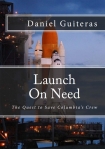Launch on Need, Daniel Guiteras [the giving tree read aloud TXT] 📗

- Author: Daniel Guiteras
Book online «Launch on Need, Daniel Guiteras [the giving tree read aloud TXT] 📗». Author Daniel Guiteras
Experiments will focus on the effects of microgravity on the human body—specifically, the loss of muscle and bone mass and dizziness, all of which continue to limit extended space travel.
The ESA’s Advanced Respiratory Monitoring System will measure the astronauts’ lungs, heart and metabolic functions while in space to determine the effects of microgravity on these systems. In addition, ESA’s BioBox, a square-shaped experiment module containing several biological experiments, will investigate the effects of weightlessness and the space environment on microorganisms.
Another experiment known as the Mediterranean Israeli Dust Experiment (MEIDEX) will measure atmospheric aerosols over the Mediterranean Sea and the Sahara Desert. MEIDEX will be conducted by STS-107’s Israeli astronaut, Ilan Ramon.
The crew’s preparation for this mission began in July 2000. General training required more than 4,800 hours. To learn the specifics of the mission, the crew members spent an additional 3,500 hundred hours studying and training with the laboratory equipment housed in the RDM of Columbia’s payload bay.
To facilitate execution of all the planned experiments during the mission, the seven-member crew of Columbia was divided into two teams, with each team to work twelve-hour shifts. Astronauts Husband, Chawla, Clark and Ramon will comprise the Red team, working during the predawn and daytime hours. McCool, Brown and Anderson of the Blue team will work during the evening and overnight hours.
Currently onboard the International Space Station (ISS) is the Exposition 6 crew, comprised of Bowersox, Budarin, and Pettit. This morning the three astronauts received a live video uplink of Columbia’s launch from Mission Control in Houston.
Today marks the 53rd day on board the ISS for the Expedition 6 astronauts. The ISS is currently in orbit at 240 statute miles above Earth, at an inclination to the equator of 51.6 degrees, while Columbia is at an altitude of approximately 178 statute miles and is inclined 39 degrees relative to the equator.
John Stangley is a freelance writer who appears periodically in the New York Times on topics of Space &Technology.
He glanced at the clock on the bedside table and suddenly the silence of his hotel room was shattered. Amidst a pile of coins, a half-eaten roll of Wint-O-green Lifesavers, his watch and wallet, was Stangley’s Blackberry, which came to life without any warning, vibrating and chattering like a fully wound set of mechanical teeth. By the third cycle, he remembered. About three weeks ago while planning this trip, he’d made dinner plans by e-mail with a friend, an acquaintance really. He got up and grabbed the pager, certain there would be an e-mail message confirming tonight’s dinner plans.
He read the e-mail message out loud, then read it again and yet again. The message was about his dinner plans, yes, but that was hardly the issue. The essence of the message had awakened Stangley’s brain to a higher state—each time he reread the e-mail, there was increased clarity. He tried to remember when he last felt such an interest in his work. Had it been more than a year ago? Before Claire died? Before she was even sick?
It was like his brain had been off and now it was on. Or maybe he had traveled back in time somehow, to the peak of his career, back when he had enjoyed a commanding control over his life, back when he was flush with ambition.
The source of this newfound energy, this sudden surge of hope, this heightened curiosity, or whatever it was, had mixed with Stangley’s seasoned understanding of space travel and caused in him an unsettling sense of worry for Columbia and her crew.
He scrolled the e-mail back to the top so he could read it once more.
John, hope you are well. I can’t make it tonight. We’ve discovered a debris strike against Columbia’s left-wing leading edge. It was a large/late hit and we’re very concerned. I will be working here until late—maybe all night. Teams are meeting to determine an appropriate course of action. No press statement given yet. I thought you could use a scoop. Get here quick. Look for me at the press conference tomorrow. Remember, you did not hear this from me!
Ken Brown
Stangley lowered his Blackberry to his lap and stared out the window, a symphony of neurons at work. “Why me?” he whispered. “Why did Ken trust me with this information?”
Chapter 6
Air Force Space Command (AFSPC)
25th Space Wings, 1st Space Control Squadron, U.S. Air Force
Cheyenne Mountain Air Force Station, Colorado Springs, Colorado
Columbia Flight Day 3
Saturday, Jan. 18, 2003
CHEYENNE MOUNTAIN AIR FORCE STATION (CMAFS) is easily the most well-protected military installation of its size anywhere in the world. The installation consists of a 4.5 acre complex built inside a man made cave with walls and ceiling of granite 2000 feet thick. There are 15 buildings, 12 of which are three stories high and perched atop 1,000-pound steel springs that allow building movement up to 12 inches in any one direction.
Inside the installation is the United States Command Center for North America. The seven centers within the complex are: Air Warning, Missile Correlation, Space Control, Operational Intelligence Watch, Systems, Weather, and Command.
Space Control Center
Mission Statement:
To ensure the department of defense’s ability to access space, to ensure U.S. freedom of action within the space medium, and to en-sure an ability to deny others the use of space, if required.
(U.S. Strategic Command Public Affairs Office)
The space control specialist who had been watching Columbia’s data points course across his monitor cleared his throat, adjusted his headset so that the microphone tip was directly in front of his mouth, and then began speaking to summon his commander.
“Please hold for the commander,” a woman’s voice replied. The specialist waited nervously at his workstation, his eyes darting among the seven monitors, checking the data logs one last time, searching





Comments (0)